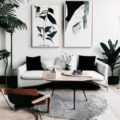Designing a home can be an exciting yet challenging task. Many people make common mistakes that can affect the overall aesthetic and functionality of their living spaces. This article will help you identify and avoid these pitfalls to create a beautiful and efficient home.
1. Overlooking the Importance of Lighting
Lighting is a critical aspect of home design that is often underestimated. Poor lighting can make even the most beautifully designed rooms look unattractive. It’s essential to consider natural light sources and complement them with appropriate artificial lighting.
Tip: Use a mix of ambient, task, and accent lighting to create a balanced and welcoming atmosphere.
2. Ignoring the Scale and Proportion
Another common mistake is ignoring the scale and proportion of furniture and decor items. Oversized furniture can make a room feel cramped, while too-small pieces can make it seem empty and uninviting.
Tip: Measure your space accurately and choose furniture that fits well within the room. Consider the height, width, and depth of each piece.
3. Skipping the Planning Stage
Many people dive into decorating without a clear plan, leading to a disjointed and chaotic look. Planning is crucial to achieving a cohesive and harmonious design.
Tip: Create a mood board or a design plan before purchasing any items. This will help you visualize the final look and ensure all elements work well together.
4. Neglecting Storage Solutions
A cluttered home can be stressful and unappealing. Failing to consider storage solutions can result in a messy and disorganized space.
Tip: Incorporate ample storage options like built-in cabinets, shelves, and multifunctional furniture to keep your home tidy.
5. Following Trends Blindly
While trends can be inspiring, following them blindly can lead to a dated and unoriginal look. It’s important to incorporate trends thoughtfully and ensure they align with your personal style.
Tip: Use trends as accents rather than the main theme. This way, your home will remain timeless and unique to you.
6. Choosing Paint Colors First
Choosing paint colors before selecting furniture and decor can limit your options and make it challenging to create a cohesive look.
Tip: Select your main pieces of furniture and decor first, then choose a paint color that complements them.
FAQ
1. Why is lighting so important in home design?
Lighting affects the mood and functionality of a space. Proper lighting can enhance the beauty of your home and make it more inviting.
2. How can I ensure my furniture is the right scale for my room?
Measure your room and the furniture pieces before purchasing. Consider the overall balance and ensure there’s enough space for movement.
3. What is the best way to start planning my home design?
Start with a clear vision. Create a mood board or design plan to visualize the elements and how they will work together in your space.
4. How can I incorporate storage without sacrificing style?
Look for multifunctional furniture and built-in storage solutions that blend seamlessly with your decor.
5. Is it okay to follow design trends?
Yes, but do so thoughtfully. Use trends as accents and ensure they fit your personal style to keep your home looking timeless and unique.









